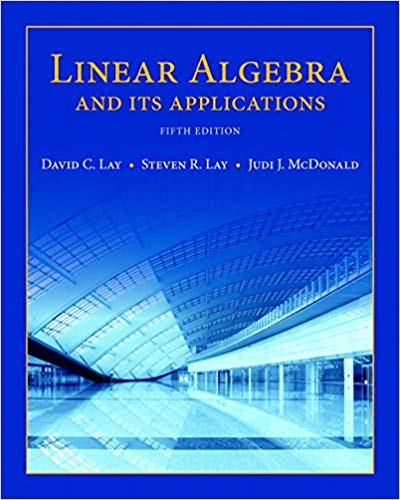
Linear Algebra and Its Applications, 5th Edition
Authors: David C. Lay, Steven R. Lay, Judi J. McDonald
ISBN-13: 978-0321982384
We have solutions for your book!
See our solution for Question 19E from Chapter 6.1 from Lay's Linear Algebra and Its Applications, 5th Edition.
Problem 19E
Chapter:
Problem:
In Exercises 19 and 20, all vectors are in Rn. Mark each statement True or False. Justify each answer. a. b. For any scalar c. If the distance from u to v equals the distance
Step-by-Step Solution
Given Information
We are given with some statements, we have to find whether they are true of False
Step-1: (a)
Statement: ${\bf{v}}{\bf{.v}} = {\left| {\left| {\bf{v}} \right|} \right|^2}$
True! We know that the length of a vector is defined as $\left| {\left| {\bf{v}} \right|} \right| = \sqrt {{\bf{v}}{\bf{.v}}} $, so we can square both sides to get: ${\bf{v}}{\bf{.v}} = {\left| {\left| {\bf{v}} \right|} \right|^2}$Therefore, the statement is
TRUE
Step-2: (b)
Statement: For any scalar ${\bf{u}}{\bf{.}}\left( {c{\bf{v}}} \right) = c\left( {{\bf{u,v}}} \right)$ .
By scalar multiplication property, we can write:
\[\left( {c{\bf{u}}} \right).{\bf{v}} = {\bf{u}}{\bf{.}}\left( {c{\bf{v}}} \right) = c\left( {{\bf{u,v}}} \right)\]Therefore, the statement is
TRUE
Step-3: (c)
Statement: If the distance from u to v equals the distance from u to- v, then u and v are orthogonal
True!
Find the distance between u and v
\[\begin{array}{l}{D_1} = \left| {\left| {{\bf{u}} - {\bf{v}}} \right|} \right|\\ = \sqrt {\left( {{\bf{u - v}}} \right).\left( {{\bf{u - v}}} \right)} \\ = \sqrt {{\bf{u}}\left( {{\bf{u - v}}} \right) - {\bf{v}}\left( {{\bf{u - v}}} \right)} \\ = \sqrt {{\bf{u}}{\bf{.u - u}}{\bf{.v - v}}{\bf{.u + v}}{\bf{.v}}} \\ = \sqrt {{{\left| {\left| {\bf{u}} \right|} \right|}^2} + {{\left| {\left| {\bf{v}} \right|} \right|}^2} - 2{\bf{u}}{\bf{.v}}} \end{array}\]Find the distance between u and -v
\[\begin{array}{l}{D_2} = \left| {\left| {{\bf{u}} + {\bf{v}}} \right|} \right|\\ = \sqrt {\left( {{\bf{u}} + {\bf{v}}} \right).\left( {{\bf{u}} + {\bf{v}}} \right)} \\ = \sqrt {{\bf{u}}\left( {{\bf{u}} + {\bf{v}}} \right) + {\bf{v}}\left( {{\bf{u}} + {\bf{v}}} \right)} \\ = \sqrt {{\bf{u}}{\bf{.u}} + {\bf{u}}{\bf{.v}} + {\bf{v}}{\bf{.u + v}}{\bf{.v}}} \\ = \sqrt {{{\left| {\left| {\bf{u}} \right|} \right|}^2} + {{\left| {\left| {\bf{v}} \right|} \right|}^2} + 2{\bf{u}}{\bf{.v}}} \end{array}\]If both distances are equal, then \[\begin{array}{l}{\left| {\left| {\bf{u}} \right|} \right|^2} + {\left| {\left| {\bf{v}} \right|} \right|^2} + 2{\bf{u}}{\bf{.v}} = {\left| {\left| {\bf{u}} \right|} \right|^2} + {\left| {\left| {\bf{v}} \right|} \right|^2} - 2{\bf{u}}{\bf{.v}}\\4{\bf{u}}{\bf{.v}} = 0\\{\bf{u}}{\bf{.v}} = 0\end{array}\]Hence the vectors are orthogonal TRUE
Step-4: (d)
Statement: For a square matrix A, vectors in Col A are orthogonal to vectors in Nul A
False! This is not always the case.
False
Step-5: (e)
Statement: If vectors ${v_1},....v{ & _p}$ span a subspace W and if x is orthogonal to each $v_j$ for j= 1, ..,p then x is in ${W^ \bot }$
True! This is true by the definition of ${W^ \bot }$,
$$x \in W,\,\,{\bf{x}}{\bf{.}}{{\bf{v}}_{\bf{j}}} = 0,\,\,1 \le j \le p$$ TRUE
We are given with some statements, we have to find whether they are true of False
Step-1: (a)
Statement: ${\bf{v}}{\bf{.v}} = {\left| {\left| {\bf{v}} \right|} \right|^2}$
True! We know that the length of a vector is defined as $\left| {\left| {\bf{v}} \right|} \right| = \sqrt {{\bf{v}}{\bf{.v}}} $, so we can square both sides to get: ${\bf{v}}{\bf{.v}} = {\left| {\left| {\bf{v}} \right|} \right|^2}$Therefore, the statement is
TRUE
Step-2: (b)
Statement: For any scalar ${\bf{u}}{\bf{.}}\left( {c{\bf{v}}} \right) = c\left( {{\bf{u,v}}} \right)$ .
By scalar multiplication property, we can write:
\[\left( {c{\bf{u}}} \right).{\bf{v}} = {\bf{u}}{\bf{.}}\left( {c{\bf{v}}} \right) = c\left( {{\bf{u,v}}} \right)\]Therefore, the statement is
TRUE
Step-3: (c)
Statement: If the distance from u to v equals the distance from u to- v, then u and v are orthogonal
True!
Find the distance between u and v
\[\begin{array}{l}{D_1} = \left| {\left| {{\bf{u}} - {\bf{v}}} \right|} \right|\\ = \sqrt {\left( {{\bf{u - v}}} \right).\left( {{\bf{u - v}}} \right)} \\ = \sqrt {{\bf{u}}\left( {{\bf{u - v}}} \right) - {\bf{v}}\left( {{\bf{u - v}}} \right)} \\ = \sqrt {{\bf{u}}{\bf{.u - u}}{\bf{.v - v}}{\bf{.u + v}}{\bf{.v}}} \\ = \sqrt {{{\left| {\left| {\bf{u}} \right|} \right|}^2} + {{\left| {\left| {\bf{v}} \right|} \right|}^2} - 2{\bf{u}}{\bf{.v}}} \end{array}\]Find the distance between u and -v
\[\begin{array}{l}{D_2} = \left| {\left| {{\bf{u}} + {\bf{v}}} \right|} \right|\\ = \sqrt {\left( {{\bf{u}} + {\bf{v}}} \right).\left( {{\bf{u}} + {\bf{v}}} \right)} \\ = \sqrt {{\bf{u}}\left( {{\bf{u}} + {\bf{v}}} \right) + {\bf{v}}\left( {{\bf{u}} + {\bf{v}}} \right)} \\ = \sqrt {{\bf{u}}{\bf{.u}} + {\bf{u}}{\bf{.v}} + {\bf{v}}{\bf{.u + v}}{\bf{.v}}} \\ = \sqrt {{{\left| {\left| {\bf{u}} \right|} \right|}^2} + {{\left| {\left| {\bf{v}} \right|} \right|}^2} + 2{\bf{u}}{\bf{.v}}} \end{array}\]If both distances are equal, then \[\begin{array}{l}{\left| {\left| {\bf{u}} \right|} \right|^2} + {\left| {\left| {\bf{v}} \right|} \right|^2} + 2{\bf{u}}{\bf{.v}} = {\left| {\left| {\bf{u}} \right|} \right|^2} + {\left| {\left| {\bf{v}} \right|} \right|^2} - 2{\bf{u}}{\bf{.v}}\\4{\bf{u}}{\bf{.v}} = 0\\{\bf{u}}{\bf{.v}} = 0\end{array}\]Hence the vectors are orthogonal TRUE
Step-4: (d)
Statement: For a square matrix A, vectors in Col A are orthogonal to vectors in Nul A
False! This is not always the case.
False
Step-5: (e)
Statement: If vectors ${v_1},....v{ & _p}$ span a subspace W and if x is orthogonal to each $v_j$ for j= 1, ..,p then x is in ${W^ \bot }$
True! This is true by the definition of ${W^ \bot }$,
$$x \in W,\,\,{\bf{x}}{\bf{.}}{{\bf{v}}_{\bf{j}}} = 0,\,\,1 \le j \le p$$ TRUE